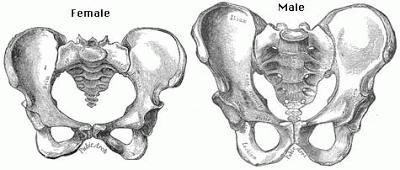
SI Joints for Female and Male (look for the red lines!)
A: It turns out that we did a few posts last year on the SI joint and the challenges it presents. You can take a look at a post Nina and I wrote on Friday, Dec 7th 2012, as well as two posts that Shari wrote on Dec. 19th and Dec. 20, 2012. Those will give you some good information about the sacrum and the SI joint to start with.Regarding Janu Sirsasana and Trikonasana, I find that if you have a problematic SI joint, these two poses can both be particularly challenging. In both cases, I try to keep a sense of evenness in the movement of the entire pelvis and sacrum as I go into, maintain, and exit from these two poses. Each pose has the potential to create a torque-ing action in the pelvis, which could then destabilize a loose SI joint on one side. So, especially as you enter the poses, move slowly enough that you can feel and listen for any sudden twists of the bones, or more likely, any changes in sensation over one SI joint. Often times, this leads to a variation of the two poses that is not quite as deep as previously practiced, but one that feels really safe and pain-free in the SI area of the back pelvis. Because there is so much personal variation in our skeleton and soft tissue structures, it is challenging to be more specific than that, and it is very helpful to have a set of experienced eyes observe you in these poses if they are challenging for you now. But I have one recommendation for each pose that can be helpful in minimizing torque.
In Trikonasana, before tipping your pelvis and torso sideways over your front leg, create a sense of your entire pelvis lifting off of your leg bones. Then, as if your pelvis had a flagpole coming up through its center, rotate your pelvis toward the front leg a bit. For example, if your front leg is the right leg, you would rotate your front left hip point towards your inner right thigh. Keep the lightness of your entire pelvis and that rotation as you tip your pelvis over your front thigh. Beyond the stretch of the inner right thigh that we often feel as we enter into the pose, keep more attention on the quality of sensation at the SI joints. And don’t let your torso bow over your front leg, as this tends to overstretch the left SI and compress the right SI.
For Janu Sirsasana, I find that modifying the direction of bend of the pelvis and torso helps to relieve some of the torque on the pelvis. Instead of turning your chest to line up with your straight leg, try keeping in line with the direction of your pelvis, which is usually somewhere between your two knees. Tip forward slowly in that direction. You will still need to be very attuned to the sensations in your SI joints, as your straight leg hamstring is going to stop the forward tip of your pelvis before your bent leg side does. It is at this moment that the torque is likely to take place. So as soon as you feel a bit of stretch in your straight leg hamstrings, stop there and wait a bit to see how things feel. You may be up a lot higher than usual, but your sacrum will thank you for it later!
—Baxter
Because these are the two most risky poses for your SI joint, if you are currently suffering from an SI injury (I've been through this), I recommend taking a break from them entirely until the pain in your joint clears up. When your joint stops hurting in your everyday life, you can return to doing these two poses using Baxter’s instructions. If you’re in a class and don’t want to sit around doing nothing while the others practice these poses, let your teacher know you’ll be doing alternative poses or severely restricted versions. For example, you can sit in the Janu Sirsasana position without bending forward at all, making sure to keep the curve in your lower back, or maybe do Paschimottanasana instead. For Trikonasana, you could do a severely modified version of the pose, perhaps with your bottom hand on a chair seat or on two blocks stacked end on end, you could rest by standing in Mountain pose or practicing Uttananasa (Standing Forward Bend).
—Nina

